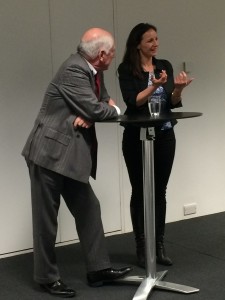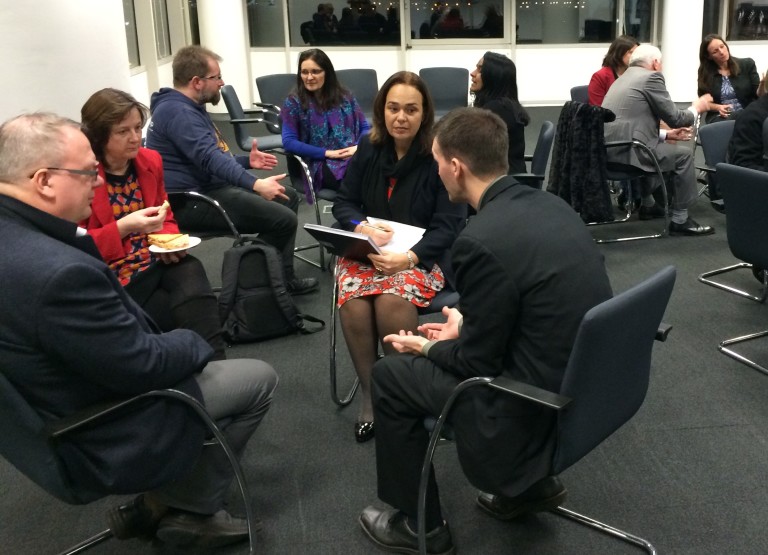A Knowledge Café usually begins with a short talk and a question, but there are other ways to set the context. A Café Debate introduces opposing views on a motion, creating a dynamic starting point. The real value comes from the conversations that follow, encouraging deeper insight rather than a simple win or lose.
In a Café Debate, the context is set by two or more people debating opposing views on a topic – the debate’s motion. This motion also forms the Café question. The Café then proceeds as usual and concludes with a vote being taken.
This process goes a little bit against the philosophy of the Café, as some people may hold on to fixed views to “win” the debate. However, this style of Café is much more about seeking “truth” than “win” or “lose.”
The real value is not in the vote’s outcome but in the conversations held in the small groups and the insights into the issue that the participants gain.
The debate serves to sharpen up and focus on the important aspects of the issue under discussion.
Unlike a traditional debate, the outcome is not some sort of verdict as to who is right and who is wrong; the value is in the conversations that are held at the tables and the insights into the issue that the participants glean.
In short, The initial debate is a powerful way of triggering deeper conversations.
The Process
Traditional formal debates can be elaborate, but a Café Debate is relatively straightforward. Here is one approach:

As in a traditional debate, there is a motion, which is the topic or resolution for the debate.
e.g., “This House believes science is a threat to humanity.”
but the word House (i.e., the group discussing the motion) is replaced by Café.
e.g., “This Café believes science is a threat to humanity.”
In a traditional debate, there are three groups: one supporting the resolution (the affirmative team), one opposing the resolution (the opposing team), and those judging the quality of the evidence and arguments and the performance in the debate. In such a debate, three members of each team usually take their turn to speak.
Why not turn your traditional debate into a Café debate and engage the audience in the discussion rather than have them sit passively listening.
In a Café Debate, however, given that the event is less about the debate and more about the conversation, it makes sense to limit the teams to one person each. Given enough time, though, there is no reason why the traditional format of 3 members per team could not be adhered to.
Two-hour Process
A 2-hour process might run something like this:
- The Café host acts as the debate moderator, driving the process actively and keeping to time.
- The host welcomes the participants, introduces the event, the motion, and the opposing debaters, and explains how a Café debate differs from a traditional debate. (5 minutes)
- The two debaters now take it, in turn, to speak for and against the motion as in a traditional debate. Debating is quite an art, and it makes good sense to find two people who are not only knowledgeable about the issue being debated but have some experience and skill in debate.
- An alternative approach is to play down the debate and set things up so that the two debaters have more of a conversation than a debate. They now become conversationalists and not debaters.
- The first person to speak presents arguments for the motion. (5 – 10 minutes)
- The second person to talk presents arguments against the motion. (5 – 10 minutes)
- A short period is then allowed for the debaters to prepare their responses while the participants discuss the issue at their tables. (5 minutes)
- Response and rebuttals from the first debater – no interruptions. (5 minutes)
- Response and rebuttals from the second debater – no interruptions. (5 minutes)
- Short period for the Café participants to ask questions of the debaters. You may skip this step if you are short on time. (10 minutes)
- The session now enters normal Café mode, where the participants discuss the motion. (3 rounds of conversation, 10 minutes each, 30 minutes total)
- The whole group conversation is like in a regular Café. Maybe even do a round-robin to share actionable insights if the group is small enough and time permits. (30 minutes)
- Final vote. A vote could optionally be taken at the start of the Café to determine to what extent people change their minds due to the interaction. (5 minutes)
- The whole process takes about 2 hours in total.
One-Hour Process
This is the unedited feedback from a Café Debate at a Legal KM Conference in London in May 2016:
* Thought-provoking and stimulated good debate.
* Great, very interactive.
* This was fun – and a good opportunity to share and chat with others.
* Very good; well-structured, good presentations, thought-provoking discussion.
* Excellent presentation/debate style, dynamic. Topic to be discussed could be less determined (i.e. difficult to argue ‘against’).
* Loved this session, really effective.
* Another of my favourite sessions, entertaining and genuinely got us talking amongst the room and meeting others.
* Liked the interactivity of the format.
* Really enjoyed this – a bit of fun and meant the audience mixed which was very useful from a networking point of view.
* Very engaging style. Felt having two debaters with opposing views gave the right environment in which to contribute freely. Credit to the debaters too – they were excellent.
If less time was available, a 1-hour process could run something like this:
- The host takes five minutes to explain and introduce the Café.
- The first debater speaks for the motion for five minutes.
- The second debater speaks against the motion for five minutes.
- The host poses the motion/question to the participants.
- The session now enters normal Café mode, where the participants discuss the motion. (3 rounds of conversation, 10 minutes each, 30 minutes total)
- In a conference setting with large round conference tables sitting six people or more, the host might ask the participants to turn to each other in 2s and 3s for discussion.
- The host brings everyone back together as a whole group to share their thoughts and then takes a vote – 15 minutes.
- Total time: 60 minutes.

Reducing Social Silencing
One of the issues you should consider when designing a Café or convening any conversation is the potential problems inherent in small group conversations. These include groupthink, group polarization, and social silencing.
An advantage of triggering a Café with a debate, where two extreme sides of an argument are put forward, is that it can give people the confidence to speak up and air their real views on the topic, however outside the mainstream or unconventional. The polarized nature of the debate in some way permits them to do this. It thus reduces social silencing to some extent.
David’s knowledge cafe, rather than just bringing up a topic for discussion, began with a debate.
The two excellent debaters provided polar opposite views on the topic as a starting point for a larger discussion.
These views, I felt, established the environment for the larger discussion – encouraging honest and more provoking conversation than expected.
It effectively gave permission for us all to push the boundaries, and feel safe to do so.
Personally, I felt more confident to offer left-field views to the group than I would have done during a normal conference discussion.
Credit: Andrew Pope, Consulting Partner, Innosis
Consider experimenting with a Café Debate to encourage deeper discussion and more diverse perspectives. Focus on the conversation rather than winning. Start with a clear motion, allow space for different views, and guide participants toward thoughtful dialogue. The goal is not agreement but a richer understanding of the issue at hand.
Posts that link to this post
- Knowledge Café: Triggering the Conversation There are a number of ways in which you can trigger the conversation
POST NAVIGATION
CHAPTER NAVIGATION
SEARCH
Blook SearchGoogle Web Search
Photo Credits: Midjourney ()
If you enjoy my work and find it valuable, please consider giving me a little support. Your donation will help cover some of my website hosting expenses.
Make a donation

